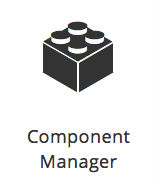Magento 2 Component Manager

We’ve recently covered such important topic as Magento 2 components, so it’s time to shed light on the Magento 2 Component Manager. Below, you will find a brief description of this solution, which is available in Magento 2 after you install the Magento application. The purpose of the component manager is simple – it helps to keep all modules, themes, language packages (Magento 2 components) up to date.

Please note that using the Magento 2 Component Manager may result in an issue when trying to roll back the system. To avoid this issue, you should set the ulimit parameter to 65536 or a higher value:
- Switch to the file system owner in Magento.
- Run the following command:
|
1 |
ulimit -s 65536 |
Table of contents
Prerequisites
To run the Magento 2 Component Manager in an appropriate way you should perform two important actions: set up cron and enter authentication keys.
You need two cron jobs running every minute and enabled as crontabs for the file system owner of Magento 2:
1. You should have root privileges to check if there is a crontab:
|
1 |
crontab -u <Magento file system owner user name> -l |
2. If there are no crontabs, set them up as follows:
|
1 |
crontab -u <Magento file system owner user name> -e |
3. In an editor, add the following code (don’t forget to replace <your Magento install dir> with your data):
|
1 2 |
*/1 * * * * php <your Magento install dir>/update/cron.php & */1 * * * * php <your Magento install dir>/bin/magento setup:cron:run & |
4. Save the changes and close the editor.
Now, you should get your authentication keys. If you already know them, skip this step.
To get your authentication keys, you should create a Magento account on Magento Connect. Please note that it is the same account you use on Magento.com. There is also a possibility that you already have your account there, so log in to the existing one.
- Find the Connect option and click it.
- Find the Developers section and choose the Secure Keys options.
- Now, you can generate a new key. In case of existing keys, use the Private key for your password and the Public key for your user name. It is also possible to create additional keys or regenerate the existing keys as well as delete or disable them.
Congratulations! You are ready to run the Magento 2 Component Manager.
Starting the Magento 2 Component Manager
Before starting the Magento 2 Component Manager, you should be logged in to your Magento 2 Admin as an administrator. Then:
- Go to System > Web Setup Wizard.
- Choose Component Manager from the available options.
- Enter your authentication keys and continue with upgrading your components.
Manageing Magento 2 Components
The Magento 2 Component Manager provides the ability to manage such components as:
- module
- language
- theme
- library
- component
- metapackage
Under component we understand any type of component required in the Magento root directory. As for metapackage, it is used for group components – Magento CE and EE.
The Magento 2 Component Manager provides the ability to perform different action on components depending on the condition of being metapackage and non-metapackage.
For instance, non-metapackage modules can be enabled, disabled, updated, and uninstalled, while languages, themes, libraries, and components can be only updated and uninstalled.
As for metapackage modules, they can be only enabled or disabled, while other components are updatable and uninstallable via the Magento 2 Component Manager.
Installing a new purchase
A new purchase is sample data or a component (free or paid) from the Magento Marketplace. The Magento 2 Component Manager shows the number of new purchases. To install them, perform the following algorithm:
- Click the install option. It is situated under the number of new purchases
- Select components you want to install. You can install everything in a bulk, or select individual components.
- Click the install button.
Updating a component
This time you should click the sync button to check if component can be updated. Then, select the Update option from the list of actions and update your component via the Magento 2 Component Manager.
Enabling/disabling a component
In case of enabling or disabling components, choose the appropriate option among available actions in the appropriate column.
Uninstalling a component
The same is about the uninstallation procedure – you should choose the Uninstall option to get rid of a component.
Magento 2 Component Manager: Readiness Check
The readiness check procedure is vital if you perform component management in Magento 2. It shows that your system and server are set up correctly, so you can seamlessly update, enable, or disable components in Magento 2. So:
- go to the Magento 2 Component Manager page;
- choose the Start Readiness Check option.
In case of success, you can manage your components.
For further information on Magento 2 Component Manager check this official documentation: .










